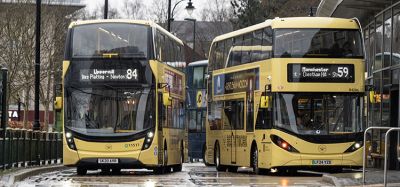Riga keeps on modernising public transport and electronic services
- Like
- Digg
- Del
- Tumblr
- VKontakte
- Buffer
- Love This
- Odnoklassniki
- Meneame
- Blogger
- Amazon
- Yahoo Mail
- Gmail
- AOL
- Newsvine
- HackerNews
- Evernote
- MySpace
- Mail.ru
- Viadeo
- Line
- Comments
- Yummly
- SMS
- Viber
- Telegram
- Subscribe
- Skype
- Facebook Messenger
- Kakao
- LiveJournal
- Yammer
- Edgar
- Fintel
- Mix
- Instapaper
- Copy Link
Posted: 22 January 2013 | Leons Bemhens, Chairman of the Board, RP SIA Rīgas satiksme | No comments yet
During the last two years, Rīgas satiksme (the Riga public transport company) has continued its programme of significant changes by successfully developing the potential of electronic payment services, expanding the fleet of low-floor trams as well as achieving the best passenger satisfaction results in the last 14 years.
Riga keeps on developing electronic payments: On 1 May 2009, the Riga public transport company fully implemented a unified electronic payment system which enabled passengers to pay their fare electronically by means of e-tickets. The new payment system allows personification of customers with a much wider variety of tickets, as well as enabling payments via the internet. The implementation of the e-ticket resulted in new types of tickets, which immediately gained popularity among pass – engers (particularly those to be used for 10 or 20 trips). There is a wide range of e-tickets available to passengers: blue personalised and non-personalised plastic smartcards, yellow cardboard tickets, whose design is changed twice a year, and paper tickets sold by drivers, which are most frequently bought by nonfrequent public transport users and tourists. The latest version of the e-ticket, introduced on 21 November 2011, is valid for 50 trips. The ticket can be loaded onto blue (personalised and non-personalised) e-tickets.
During the last two years, Rīgas satiksme (the Riga public transport company) has continued its programme of significant changes by successfully developing the potential of electronic payment services, expanding the fleet of low-floor trams as well as achieving the best passenger satisfaction results in the last 14 years. Riga keeps on developing electronic payments: On 1 May 2009, the Riga public transport company fully implemented a unified electronic payment system which enabled passengers to pay their fare electronically by means of e-tickets. The new payment system allows personification of customers with a much wider variety of tickets, as well as enabling payments via the internet. The implementation of the e-ticket resulted in new types of tickets, which immediately gained popularity among pass - engers (particularly those to be used for 10 or 20 trips). There is a wide range of e-tickets available to passengers: blue personalised and non-personalised plastic smartcards, yellow cardboard tickets, whose design is changed twice a year, and paper tickets sold by drivers, which are most frequently bought by nonfrequent public transport users and tourists. The latest version of the e-ticket, introduced on 21 November 2011, is valid for 50 trips. The ticket can be loaded onto blue (personalised and non-personalised) e-tickets.
During the last two years, Rīgas satiksme (the Riga public transport company) has continued its programme of significant changes by successfully developing the potential of electronic payment services, expanding the fleet of low-floor trams as well as achieving the best passenger satisfaction results in the last 14 years.
Riga keeps on developing electronic payments
On 1 May 2009, the Riga public transport company fully implemented a unified electronic payment system which enabled passengers to pay their fare electronically by means of e-tickets. The new payment system allows personification of customers with a much wider variety of tickets, as well as enabling payments via the internet. The implementation of the e-ticket resulted in new types of tickets, which immediately gained popularity among pass – engers (particularly those to be used for 10 or 20 trips). There is a wide range of e-tickets available to passengers: blue personalised and non-personalised plastic smartcards, yellow cardboard tickets, whose design is changed twice a year, and paper tickets sold by drivers, which are most frequently bought by nonfrequent public transport users and tourists. The latest version of the e-ticket, introduced on 21 November 2011, is valid for 50 trips. The ticket can be loaded onto blue (personalised and non-personalised) e-tickets. Like other types of e-ticket, it is valid for 12 months from the moment of purchase. The 50-trip ticket is meant for those passengers who use various means of transportation on a regular basis. With the new ticket, regular passengers can save money. Thanks to the new payment system, passengers are now offered a wide range of tickets: for 1, 2, 4, 5, 10, 20 and 50 trips, 24-hours, 3 and 5 days, as well as one-month and group tickets.
New functions of e-ticket
The e-ticket has recently acquired new functions and applications. On 15 August 2012, Riga started to introduce ‘pupil cards’ – a combina – tion of a pupil’s certificate and an e-ticket. The pupil’s e-card functions as an e-ticket for public transport, but having a particular school’s sticker on it, it also doubles and functions as a pupil’s certificate. In the future, pupils will be able to use the e-card to pay for their school lunch, in ID systems of their education institutions, as well as to get discounts when visiting Riga museums, theatres and the zoo, etc. The e-card is issued to pupils of certain ages in Riga comprehensive schools, as well as to those pupils whose declared place of residence is in Riga, although they attend schools outside Riga.
In 2011, the e-ticket integrated extra functions of delivering social services to low-income population groups – the possibility of getting night shelter and food in hot food distribution centres. Residents with low incomes and homeless people can use these functions in 14 social aid centres across Riga: in six food distribution centres, seven asylums and a one day centre for homeless people. It is planned that in the future it will be also possible to use the e-ticket to receive benefits and buy food in social stores.
Becoming more environmentally-friendly
One of the key criteria of modernising the rolling stock of Rīgas satiksme is to make the vehicles as friendly to the environment and residents as possible. The company also abides by this principle when developing other services, for example, when building new bicycle parking-lots on the streets of Riga and by using electromobiles (electric cars) for managing car parks in the city. So far, Rīgas satiksme has organised 21 parking-lots for bicycles, located according to the recommendations of cyclists.
Rīgas satiksme has also recently started to run its first five electromobiles which are used to service the city’s car parks, as well as to fulfil the day-to-day functions of the Rīgas satiksme car depot. For the time being it’s just an experiment, and the cars will be used all year round, including winter, which is the most serious season for electromobiles. After evaluating the results of the first five electric cars, Rīgas satiksme will decide whether to expand its fleet of electromobiles.
The electromobiles are made by Finnish company Valmet Automotive, their maximum speed is 112km/h. They are front drive, two-seater vehicles with an 800-litre luggage compartment. The electromobile is charged from the conventional power network (220 V), and is fully loaded after 6-8 hours. After that, it can run up to 160km. The electromobiles are certified and meet all EU requirements. It should be emphasised that the introduction of electromobiles and their charging infrastructure in Riga is provided for by the city’s sustainable energy action plan for 2010-2020. Riga municipality is working purposefully to implement this plan, and the first five electromobiles is the first step towards a wider use of electromobiles in the utility services of Riga municipality in the future.
Public transport satisfaction is growing
In the process of developing public transport services and the route network, residents’ opinions and evaluations are crucial for Rīgas satiksme. Therefore, the company carries out regular passenger opinion polls. Where possible, the process of planning the renovation of rolling stock and route changes follows the recommendations of passengers and trends in passenger flow. As the latest surveys show, 81% of Riga residents are generally satisfied with public transport services in the city – the highest in 14 years since the company started conducting regular opinion polls.
The company has also recently witnessed an increase in the number of passengers using public transport daily or almost every day (50%). On workdays, approximately 55% of customers use public transport twice a day.
Sixty-two per cent of Riga residents using public transport have noted that reaching a public transport stop takes them more than five minutes, but 89% of public transport users are satisfied with the availability of information about public transport, 81% are satisfied with planning the network of public transport routes, and 78% highly appreciate the level of comfort provided by Riga public transport.
Bus and trolleybus fleet to be renovated
One of preconditions for positive evaluation of Riga public transport services is regular reno – vation of the rolling stock. It is evidenced by a survey conducted on the website of Rīgas satiksme where 72% of respondents recently positively answered the question Is it important for you to use new and quality public transport vehicles? Nine per cent of respondents stressed that new vehicles are safer and as many pointed out that the new vehicles have been a factor in them choosing to travel by public transport. Only 10% of respondents say that quality of public transport does not matter to them.
Given the depreciation of public transport and the importance which passengers attach to the quality of public transport, Rīgas satiksme will continue the renovation of its rolling stock – in the coming five years the company will buy 125 low-floor trolleybuses and 175 new low-floor buses.
Even longer trams
The first low-floor trams were delivered to Riga in 2010. These Czech-made Škoda 15T-Riga trams are 31.64m-long, 2.5m-wide and have capacity for 300 passengers. However, earlier in 2012, four of the six new, extended four-section low-floor Rīga 15T-1 trams started running in the city’s streets. They differ from 15T-Riga trams with a bigger capacity, having one more section. This model is 41m-long, has eight doors, 79 seats and 353 places for standing, which brings its total capacity to 432 passengers. The maximum operating speed of the tram is 70km/h, and the price is €3.27 million per tram. The new trams are expected to be carrying passengers in Riga for the next 30 years. By the end of 2012, Riga will get two more Rīga 15T-1 trams.
Developing digital communication
Given the popularity of digital media, Rīgas satiksme has also upgraded its digital communi – cation tools. We have functionally improved our website, created company profiles on Twitter, Facebook, YouTube and Draugiem.lv – the Latvian equivalent of Facebook.
Following the wishes of our customers, the Rīgas satiksme website recently underwent significant changes in design and functionality. Priority was given to route searchers and information on the e-ticket and available types of tickets. Because many passengers look at schedules and search routes via their mobile phones, the new website is also available in the modern mobile version.
Every year Rīgas satiksme’s website registers more than 1.5 million unique visitors, and in 2011 pages with route schedules were con – sulted more than 53 million times. Eighty per cent of Rīgas satiksme webpage visitors everyday are looking for information on routes, schedules and public transport departure times. Customers also search information about the types of e-tickets, their purchase and reloading possibilities.
First social campaigns
To draw media and public attention to topical issues and problems in the field of public transport, Rīgas satiksme launched several social campaigns which included campaigns against vandalism on public transport and campaigns for safe travelling.
The objective of the campaign against vandalism was to attract media and public attention to the issues of vandalism in Riga public transport, as every year Rīgas satiksme spends significant amounts of money on eliminating the consequences of vandalism (€189,000 in 2010). We called this campaign Handwork… it shows because spoiling and demolishing public transport is a handwork seen by both passengers and Rīgas satiksme staff. Cleaning, repainting and repairing public transport is also a handwork done by Rīgas satiksme staff. As for cleanness and visual state of public transport, it is seen and appreciated by passengers every day. The campaign budget was rather small at just €2,270, yet the financial effect in the first six months exceeded €139,000. In the six months following the campaign, losses from vandalism decreased by up to four times. The campaign was given wide media coverage, as well as positive appraisal from passengers and the company’s staff. But what is most important is that it positively influenced the statistics of incidents – in December there were only seven incidents, which was the lowest number in 2011. During the six months follow – ing the campaign the number of accidents dropped by twice the amount.
The goal of Rīgas satiksme’s campaign for safe travelling – known as HOLD ON! (TURIES!) – was to draw passengers’ attention to safe travelling on urban public transport and to urge them not to forget to hold on when travelling in a bus, a trolleybus or a tram in order not to fall. The campaign was given wide media coverage, as well as positive appraisal from passengers and the company’s staff.
About the author
Leons Bemhens has been Chairman of the Board at Rigas satiksme since 2003. Leons graduated from the Latvian Agricultural Academy, Faculty of Agri – cultural Mechanisation, profession – Management and Operation of Motor Transport. In 1977, Leons started to work as an Engineer at the Technical Unit of Riga Bus Transport, where he was later appointed to Chief Mechanic. In 1993 Leons was appointed Director of the newly established Riga municipal transport company, Talava.
Related topics
Ticketing & Payments
Issue
Issue 6 2012
Related cities
Eastern Europe
Related organisations
Rigas satiksme
Related people
Leons Bemhens








